
Concept explainers
Draw the organic products formed in each reaction.
a.  d.
d.  g.
g. 
b.  e.
e.  h.
h. 
c.  f.
f. 
(a)
Interpretation: The organic product formed in the given reaction is to be drawn.
Concept introduction: The dehydrohalogenation reaction of primary alkyl halide mostly favors
Answer to Problem 8.54P
The organic product formed in the given reaction is,
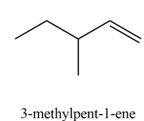
Explanation of Solution
The given reaction involves primary alkyl halide and strong bulky base. Primary alkyl halides can undergo substitution as well as elimination reactions. Since, the base is strong and bulky, it undergoes elimination reaction through
The corresponding reaction is shown below.

Figure 1
(a) The organic product formed in the given reaction is drawn in Figure 1.
(b)
Interpretation: The organic product formed in the given reaction is to be drawn.
Concept introduction: The dehydrohalogenation reaction of primary alkyl halide mostly favors
Answer to Problem 8.54P
The organic product formed in the given reaction is,
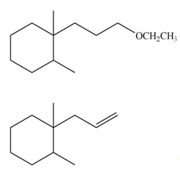
Explanation of Solution
In the given reaction, the alkyl halide is primary and base is strong, negatively charged base as well as nucleophile. Primary alkyl halides can undergo substitution as well as elimination reactions. Since, the base is strong, and also a strongnucleophile, the given halide undergoes substitution reaction through
The corresponding reaction is shown below.

Figure 2
The organic product formed in the given reaction is drawn in Figure 2.
(c)
Interpretation: The organic product formed in the given reaction is to be drawn.
Concept introduction: A carbon atom bonded to two halogen groups is called germinal dihalides. Geminal dihalides undergo double dehydrohalogenation reaction in the presence of excess base to form alkyne as the final product. The reaction prefers elimination pathway.
Answer to Problem 8.54P
The organic product formed in the given reaction is,
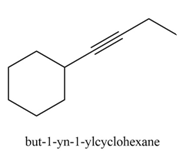
Explanation of Solution
In the given reaction, germinal dihalide is the starting material and amine base is strong, negatively chargedand present in excess amount
The corresponding reaction is shown below.

Figure 3
The organic product formed in the given reaction is drawn in Figure 3.
(d)
Interpretation: The organic product formed in the given reaction is to be drawn.
Concept introduction: The dehydrohalogenation reaction of primary alkyl halide mostly favors
Answer to Problem 8.54P
The organic product formed in the given reaction is,
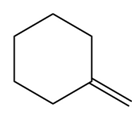
Explanation of Solution
In the given reaction, the alkyl halide is primary and base is strong, but non-nucleophilic. Primary alkyl halides can undergo substitution as well as elimination reactions. Since, the base is strong and non-nucleophilic, it undergoes elimination reaction through E2 pathway.
The corresponding reaction is shown below.

Figure 4
The organic product formed in the given reaction is drawn in Figure 4.
(e)
Interpretation: The organic product formed in the given reaction is to be drawn.
Concept introduction: The dehydrohalogenation reaction of primary alkyl halide mostly favors
Answer to Problem 8.54P
The organic product formed in the given reaction is,
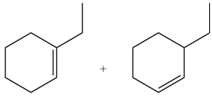
Explanation of Solution
In the given reaction, the alkyl halide is secondary and base is a strong, negatively charged bulky base. Secondaryalkyl halides can undergo substitution as well as elimination reactions. Since, the base is strong and bulky it undergoes elimination reaction through E2 pathway.
The corresponding reaction is shown below.

Figure 5
The organic product formed in the given reaction is drawn in Figure 5.
(f)
Interpretation: The organic product formed in the given reaction is to be drawn.
Concept introduction: The dehydrohalogenation reaction of primary alkyl halide mostly favors
Answer to Problem 8.54P
The organic product formed in the given reaction is,
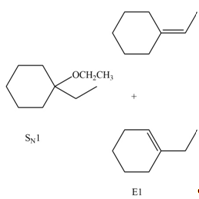
Explanation of Solution
The given reaction involves tertiary alkyl halide, weak base that is also a weak nucleophile. These conditions make the given halide (tertiary) suitable to undergo either substitution by
The corresponding reaction is shown below.

Figure 6
The organic product formed in the given reaction is drawn in Figure 6.
(g)
Interpretation: The organic product formed in the given reaction is to be drawn.
Concept introduction: Vicinal dihalides are the compounds in which the adjacent carbon atoms possess halogen groups (one on each carbon). These dihalides yield alkynes when treated with two equivalents of sodamide
Answer to Problem 8.54P
The organic product formed in the given reaction is,
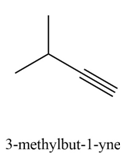
Explanation of Solution
The given alkyl halide is vicinal dihalide.
Vicinal dihalides are the compounds in which the adjacent carbon atoms possess halogen groups (one on each carbon). These dihalides yield alkynes when treated with two equivalents of sodamide
The corresponding reaction is shown below.
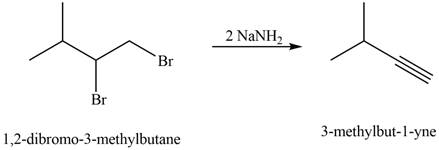
Figure 7
The organic product formed in the given reaction is drawn in Figure 7.
(h)
Interpretation: The organic product formed in the given reaction is to be drawn.
Concept introduction: The dehydrohalogenation reaction of alkyl halide mostly favors
Answer to Problem 8.54P
The organic product formed in the given reaction is,

Explanation of Solution
The given alkyl halide is tertiary. Water is a weak base. These conditions make the given halide (tertiary) suitable to undergo substitution as well as elimination reaction
The corresponding reaction is shown below.
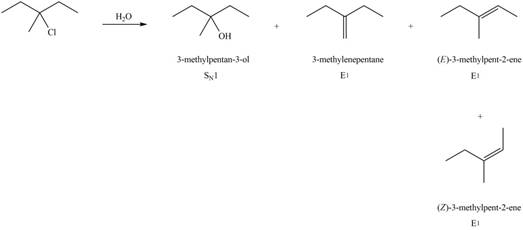
Figure 8
The organic product formed in the given reaction is drawn in Figure 8
Want to see more full solutions like this?
Chapter 8 Solutions
Organic Chemistry
Additional Science Textbook Solutions
Microbiology Fundamentals: A Clinical Approach
SEELEY'S ANATOMY+PHYSIOLOGY
Organic Chemistry
General, Organic, and Biological Chemistry - 4th edition
Physical Universe
Human Anatomy & Physiology (2nd Edition)
- 1. Consider these three reactions as the elementary steps in the mechanism for a chemical reaction. 2600 2400 2200 2000 1800 1600 1400 1200 1000 800 Potential Energy (kJ) 600 400 200 0 -200- -400 -600- -800 (i) Cl₂ (g) + Pt(s) → 2Cl (g) + Pt(s) (ii) Cl (g)+ CO (g) + Pt (s) → CICO (g) + Pt (s) Ea = 1550 kJ Ea = 2240 kJ (iii) Cl (g) + CICO (g) → Cl₂CO (g) Ea = 2350 kJ AH=-950 kJ ΔΗ = 575 ΚΙ AH=-825 kJ a. Draw the potential energy diagram for the reaction. Label the data points for clarity. The potential energy of the reactants is 600 kJ Reaction Progress b. What is the overall chemical equation? c. What is the overall change in enthalpy for the above chemical reaction? d. What is the overall amount of activation energy for the above chemical reaction? e. Which reaction intermediate would be considered a catalyst (if any) and why? f. If you were to add 2700kJ of energy to the reaction (e.g. 2700 kl of heat or electricity), would you be able to make the reaction reverse itself (i.e. have…arrow_forwarddraw the enolate anion and the carbonyl that would be needed to make this product through an aldol addition reaction.arrow_forwardDraw the Michael Adduct and the final product of the Robinson annulation reaction. Ignore inorganic byproducts.arrow_forward
- Draw the Michael adduct and final product of the Robinson annulation reaction. Ignore inorganic byproductsarrow_forwardPost Lab Questions. 1) Draw the mechanism of your Diels-Alder cycloaddition. 2) Only one isomer of product is formed in the Diels-Alder cycloaddition. Why? 3) Imagine that you used isoprene as diene - in that case you don't have to worry about assigning endo vs exo. Draw the "endo" and "exo" products of the Diels-Alder reaction between isoprene and maleic anhydride, and explain why the distinction is irrelevant here. 4) This does not hold for other dienes. Draw the exo and endo products of the reaction of cyclohexadiene with maleic anhydride. Make sure you label your answers properly as endo or exo. 100 °C Xylenes ??? 5) Calculate the process mass intensity for your specific reaction (make sure to use your actual amounts of reagent).arrow_forwardIndicate the product(s) A, B C and D that are formed in the reaction: H + NH-NH-CH [A+B] [C+D] hydrazonesarrow_forward
- How can you prepare a 6 mL solution of 6% H2O2, if we have a bottle of 30% H2O2?arrow_forwardHow many mL of H2O2 from the 30% bottle must be collected to prepare 6 mL of 6% H2O2.arrow_forwardIndicate the product(s) B and C that are formed in the reaction: HN' OCH HC1 B + mayoritario C minoritario OCH3arrow_forward
- Indicate the product(s) that are formed in the reaction: NH-NH, OCH3 -H₂O OCH3arrow_forward21.38 Arrange the molecules in each set in order of increasing acidity (from least acidic to most acidic). OH OH SH NH2 8 NH3 OH (b) OH OH OH (c) & & & CH3 NO2 21.39 Explain the trends in the acidity of phenol and the monofluoro derivatives of phenol. OH OH OH OH PK 10.0 PK 8.81 PK 9.28 PK 9.81arrow_forwardidentify which spectrum is for acetaminophen and which is for phenacetinarrow_forward
 ChemistryChemistryISBN:9781305957404Author:Steven S. Zumdahl, Susan A. Zumdahl, Donald J. DeCostePublisher:Cengage Learning
ChemistryChemistryISBN:9781305957404Author:Steven S. Zumdahl, Susan A. Zumdahl, Donald J. DeCostePublisher:Cengage Learning ChemistryChemistryISBN:9781259911156Author:Raymond Chang Dr., Jason Overby ProfessorPublisher:McGraw-Hill Education
ChemistryChemistryISBN:9781259911156Author:Raymond Chang Dr., Jason Overby ProfessorPublisher:McGraw-Hill Education Principles of Instrumental AnalysisChemistryISBN:9781305577213Author:Douglas A. Skoog, F. James Holler, Stanley R. CrouchPublisher:Cengage Learning
Principles of Instrumental AnalysisChemistryISBN:9781305577213Author:Douglas A. Skoog, F. James Holler, Stanley R. CrouchPublisher:Cengage Learning Organic ChemistryChemistryISBN:9780078021558Author:Janice Gorzynski Smith Dr.Publisher:McGraw-Hill Education
Organic ChemistryChemistryISBN:9780078021558Author:Janice Gorzynski Smith Dr.Publisher:McGraw-Hill Education Chemistry: Principles and ReactionsChemistryISBN:9781305079373Author:William L. Masterton, Cecile N. HurleyPublisher:Cengage Learning
Chemistry: Principles and ReactionsChemistryISBN:9781305079373Author:William L. Masterton, Cecile N. HurleyPublisher:Cengage Learning Elementary Principles of Chemical Processes, Bind...ChemistryISBN:9781118431221Author:Richard M. Felder, Ronald W. Rousseau, Lisa G. BullardPublisher:WILEY
Elementary Principles of Chemical Processes, Bind...ChemistryISBN:9781118431221Author:Richard M. Felder, Ronald W. Rousseau, Lisa G. BullardPublisher:WILEY





